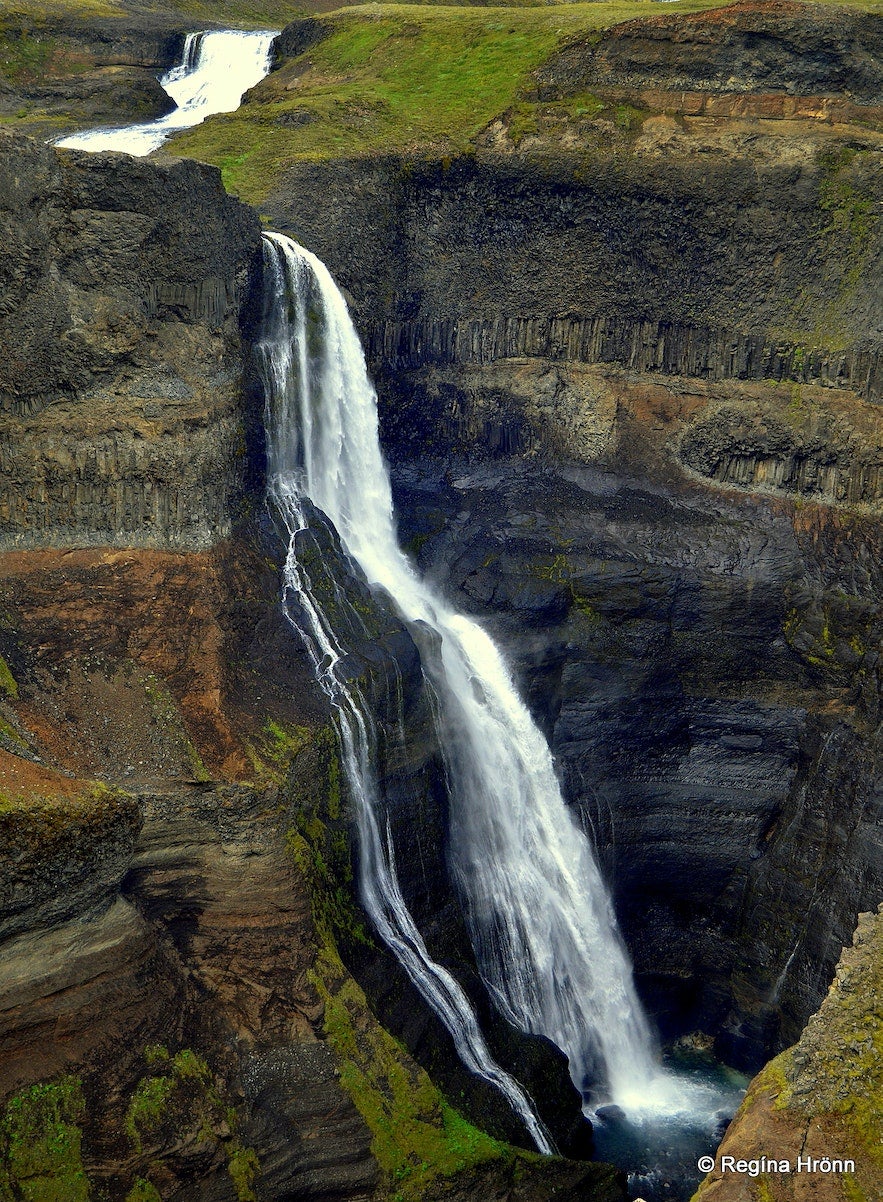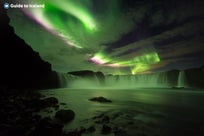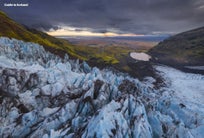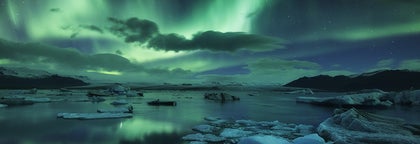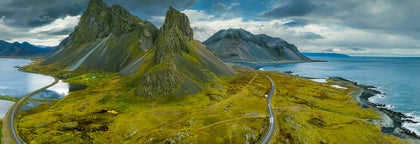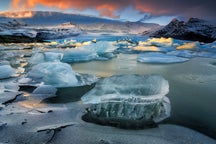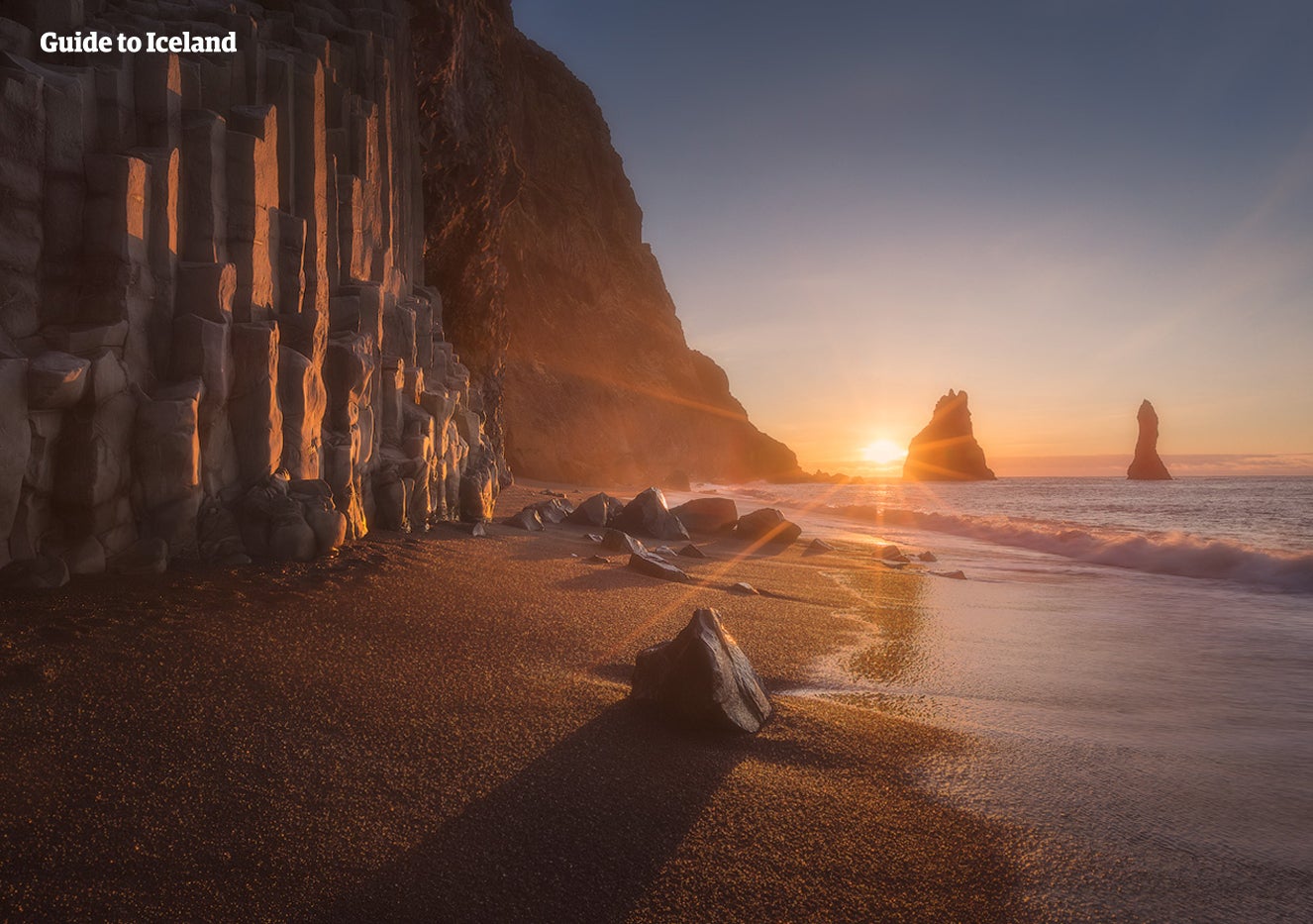
Top 20 Most Beautiful Waterfalls in Iceland

- 20. Oxararfoss Waterfall
- 19. Selfoss Waterfall
- 18. Hrafnbjargafoss Waterfall
- 17. Hengifoss Waterfall
- 16. Kirkjufellsfoss Waterfall
- 15. Bruarfoss Waterfall
- 14. Haifoss Waterfall
- 13. Hraunfossar Waterfall
- 12. Klifbrekkufoss Waterfall
- 11. Aldeyjarfoss Waterfall
- 10. Kvernufoss Waterfall
- 9. Hrauneyjafossar Waterfall
- 8. Glymur Waterfall
- 7. Dettifoss Waterfall
- 6. Svartifoss Waterfall
- 5. Godafoss Waterfall
- 4. Dynjandi Waterfall
- 3. Seljalandsfoss Waterfall
- 2. Gullfoss Waterfall
- 1. Skogafoss Waterfall
- Map of the most beautiful waterfalls in Iceland
Discover the most beautiful waterfalls in Iceland. Learn about the most famous waterfalls in Iceland, the best waterfalls to visit, and the stories behind them.
A trip to Iceland isn't complete without visiting the country's magnificent waterfalls. Each waterfall has its distinct character, dazzling onlookers with its unique shape, size, sound, and surrounding natural features. To reach them, you can either join our waterfall tours or rent a car on Iceland's cheapest car rental marketplace. If you want to go waterfall chasing around the country, book charming guesthouses in Iceland wherever you go and enjoy the sights.
Iceland's many glaciers and spectacular geography combine to create some of the most attractive and unique waterfalls on the planet. Glacial waters carve through the beautiful volcanic landscape, creating fascinating waterfalls.
We've gathered 20 of the most notable waterfalls in Iceland, with amazing photos representing each one. These offer a glimpse of the excellent variety of waterfalls you can find. As with most top lists, not everyone will agree with the ordering, but no one can argue these waterfalls don't belong on a list of beautiful waterfalls.
You will quickly notice that the names of most of these waterfalls end with "-foss." That's because "foss" is the Icelandic word for waterfall!
20. Oxararfoss Waterfall
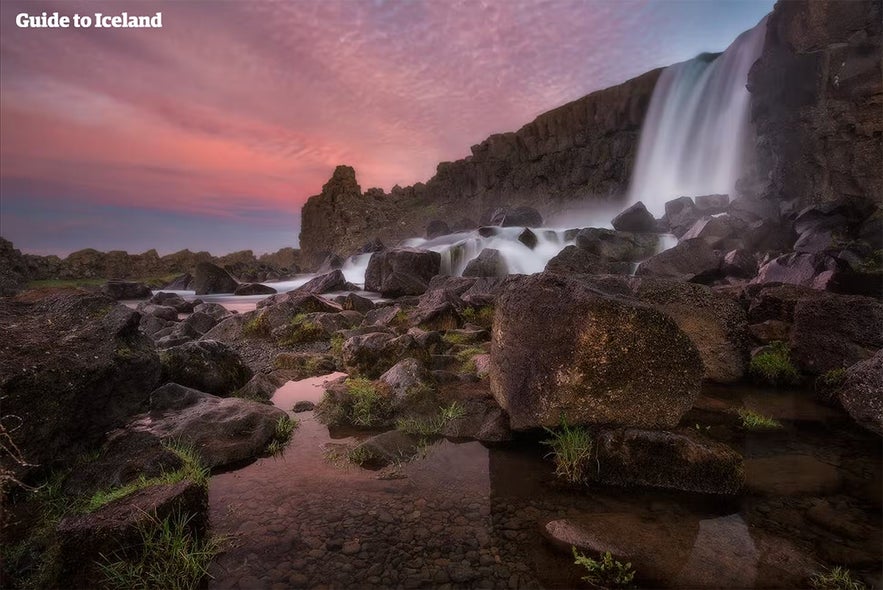
To start things off, we have Oxararfoss, one of the most visited waterfalls in Iceland. It's located in Thingvellir National Park, famous for being the historical founding site of Iceland's Althingi in 930 AD, the oldest national assembly in the world.
The park was designated a UNESCO Heritage Site in 2014 for its cultural significance. Therefore, despite being frequently visited, Oxararfoss waterfall is not quite the area's main attraction.
Oxararfoss descends through a rift in the Oxara river, which eventually flows into Thingvallavatn, the largest lake in Iceland. This waterfall is easy to visit as Thingvellir is part of the Golden Circle, a popular route among Iceland visitors.
Thingvellir is also known for its location between North America's and Eurasia's tectonic plates. As the plates drift apart, many fissures and cracks in the ground can be found in the area. The most famous of these rifts is Silfra fissure, where brave visitors can go on snorkeling tours in the crystal clear water of Silfra.
19. Selfoss Waterfall
 Not to be confused with a town of the same name in South Iceland, Selfoss waterfall is located in the North, about 100 miles (160 kilometers) from Akureyri.
Not to be confused with a town of the same name in South Iceland, Selfoss waterfall is located in the North, about 100 miles (160 kilometers) from Akureyri.
This waterfall is distinct in that it is much broader than tall. Its height is only about 36 feet (11 meters), but its width is about 330 feet (100 meters), making this waterfall more like a series of waterfalls among the cliffs.
On the other side are cliffs that serve as a natural viewing platform of the waterfall. Visitors should be careful as the rocks can be slippery, especially in the winter.
Just slightly downstream from this impressive waterfall is another even more impressive waterfall, Dettifoss, the second most powerful waterfall in Europe. It's included in this list, but you must continue reading to find out where it ranks!
18. Hrafnbjargafoss Waterfall
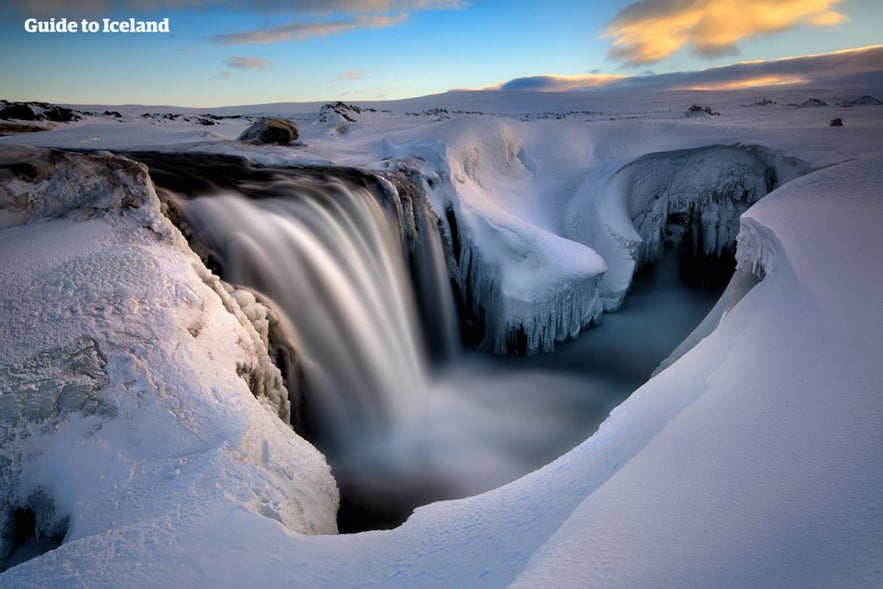
Hrafnabjargafoss is a beautiful horseshoe-shaped waterfall in the mighty Skjalfandafljot glacier river in North Iceland. The meltwater of the largest glacier in Europe, Vatnajokull, feeds the river.
Hrafnabjargafoss (which translates to Raven Cliff Falls) is relatively "hidden" among the cliffs, giving you an excellent downward view of the multiple chutes that the water flows down from in the shape of a U. In the same river, you will find another beautiful waterfall Aldeyjarfoss, and the historical Godafoss waterfall which (spoiler alert!) will appear later on this list.
Therefore, anyone visiting the area should see all three waterfalls to make the most of their journey. Another horseshoe-shaped natural wonder, the magnificent Asbyrgi canyon, is just north of this waterfall.
17. Hengifoss Waterfall
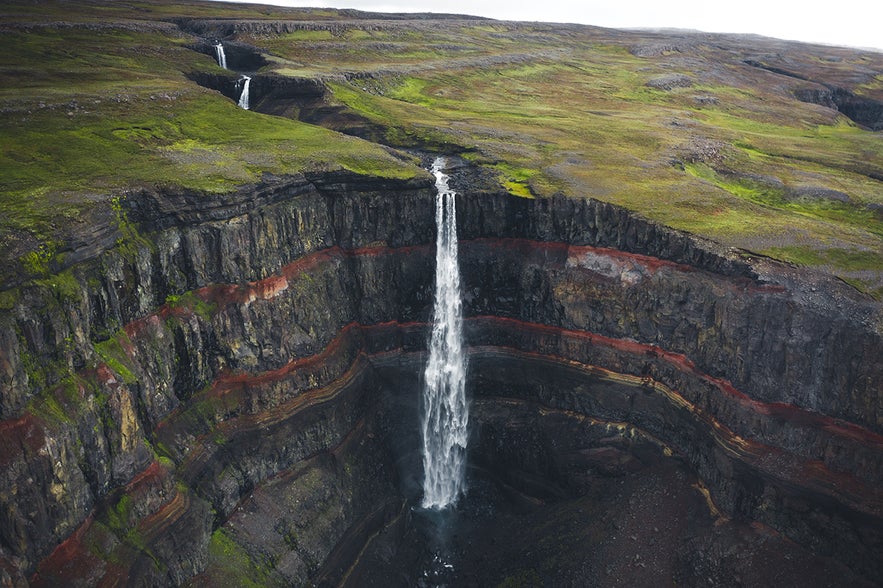
The aptly named Hengifoss waterfall, which translates to "Hanging Falls," is located in East Iceland and is the third-tallest waterfall in the country. It flows down a cliff of basaltic strata with thin layers of red clay between. The steep fall down the dramatic cliff gave it its name, as it appears as if the water is "hanging" down the precipice.
Hengifoss waterfall is located within the Vatnajokull National Park, the largest national park in Iceland and the second largest in Europe. The closest town is Egilsstadir, 22 miles (35 kilometers) from the waterfall.
When hiking towards Hengifoss waterfall from the nearby parking lot, you will first pass by another beautiful but smaller waterfall called Litlanesfoss (seen below). It is characterized by its sharp basalt columns surrounding its water flow and is well worth a stop.
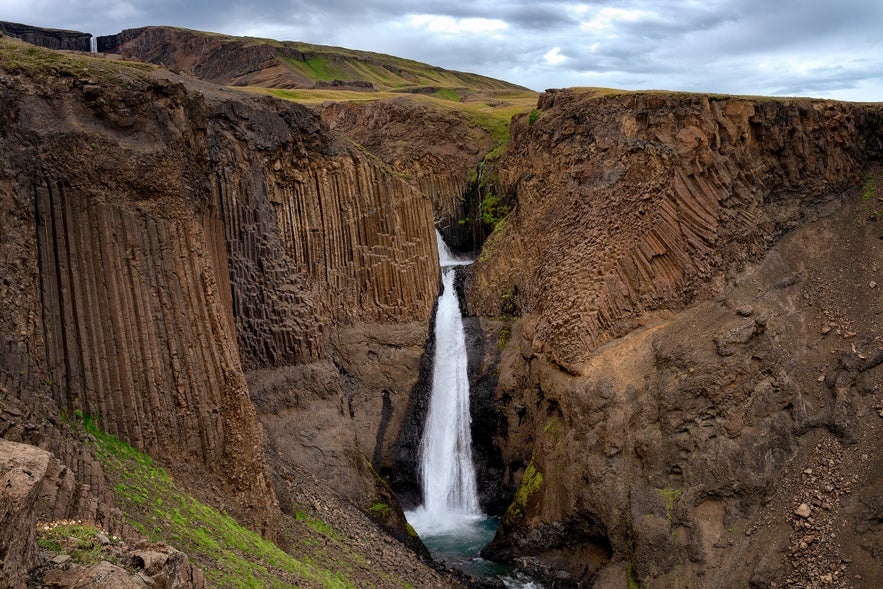
These waterfalls eventually run into Lake Lagarfljot, a mysterious lake known for the sea monster that allegedly swims in its water, the Lagarfljotsormurinn. This lake serpent was first mentioned in Icelandic chronicles from 1345, and there are still reported sightings of it into the 21st century.
16. Kirkjufellsfoss Waterfall
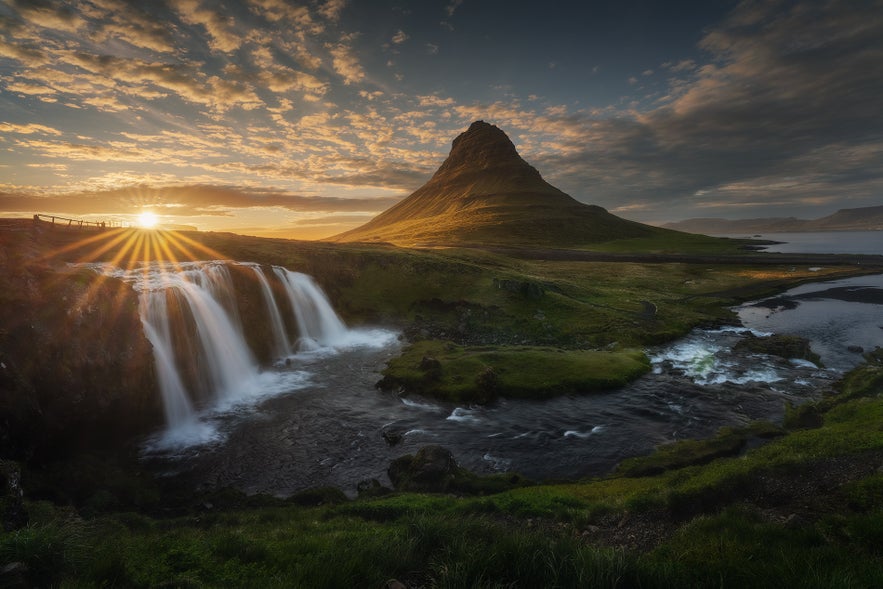 This small and charming waterfall sits near the impressive Mount Kirkjufell at Grundarfjordur bay on the Snaefellsnes peninsula. It is particularly scenic for photographers when capturing the water's serenity against the dramatic mountain in the background.
This small and charming waterfall sits near the impressive Mount Kirkjufell at Grundarfjordur bay on the Snaefellsnes peninsula. It is particularly scenic for photographers when capturing the water's serenity against the dramatic mountain in the background.
Kirkjufellsfoss waterfall is one of the best waterfalls to photograph in Iceland. It is easily accessible with no hiking required. The area can look dramatically different but just as beautiful, depending on the time of year. Whether it's bathed under the light of the midnight sun, as seen above, or underneath the northern lights in the winter, as seen below, it's a stunning sight to behold.
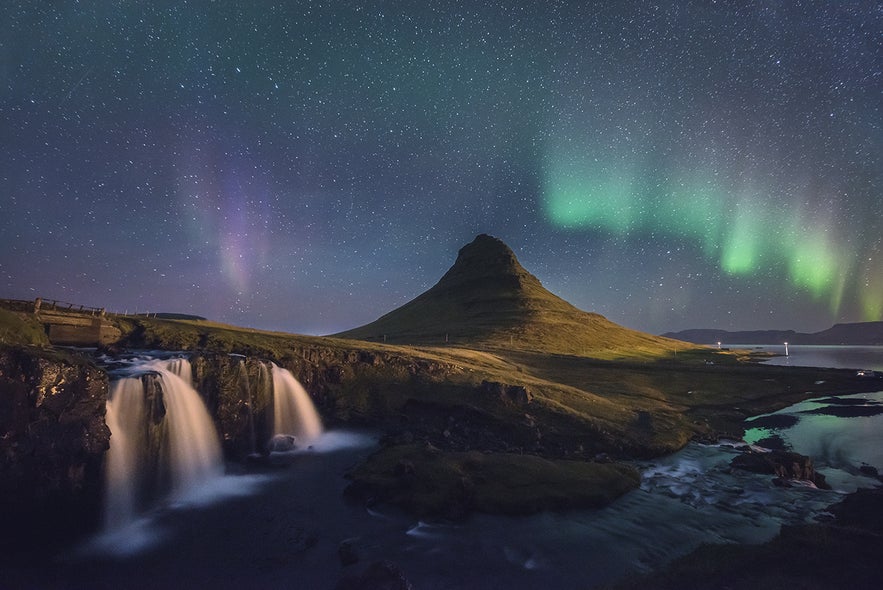
This waterfall probably wouldn't have made the list if it were not located right by this iconic mountain. But when evaluating a waterfall's beauty, the surroundings and backdrop of the waterfall play a significant role. After all, the waterfall is named after the mountain!
Choose from a wide selection of Snaefellsnes tours if you're planning to see this waterfall, along with the beautiful Mount Kirkjufell by its side.
15. Bruarfoss Waterfall
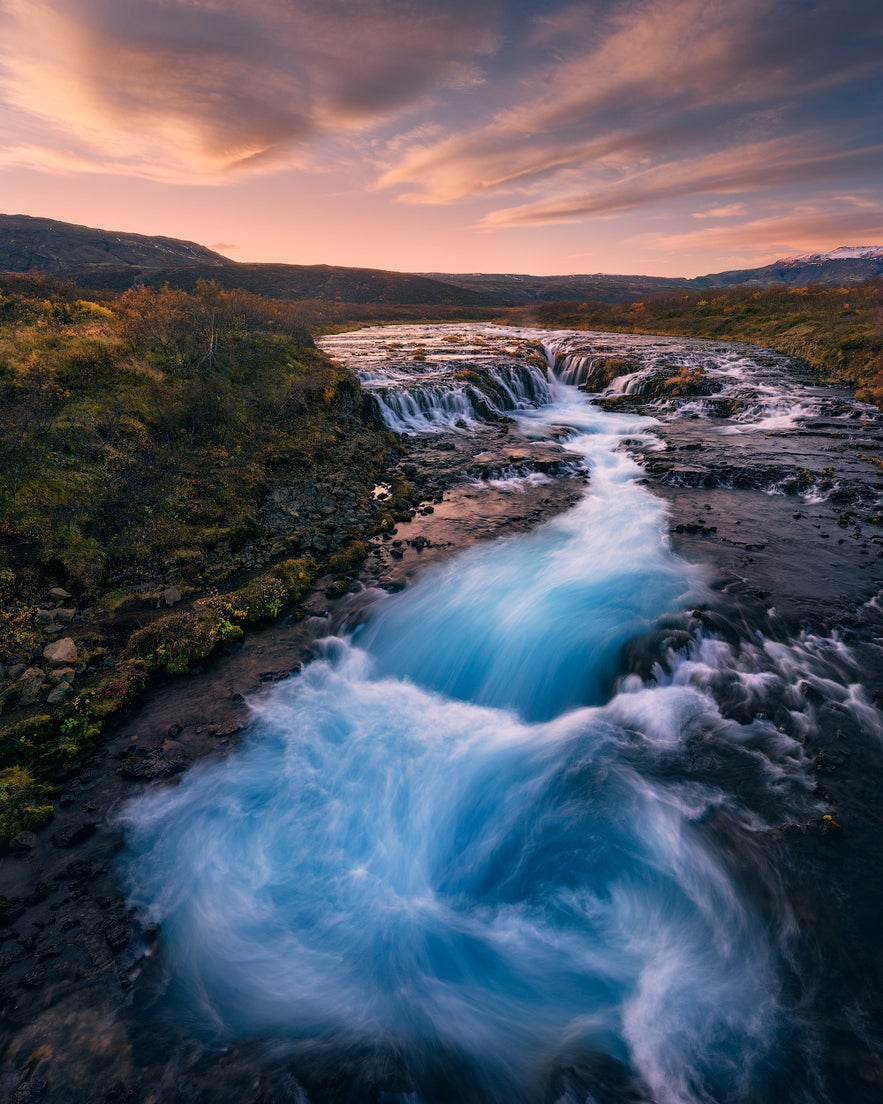 These small waterfalls are located in the Bruara river, in the Grimsnes area of Southwest Iceland. They are considered something of a hidden gem. Until recently, it required an hour-long hike to reach it, but now there is a parking lot a short walk from the river, making it more accessible. Keep in mind you need to pay a small parking fee.
These small waterfalls are located in the Bruara river, in the Grimsnes area of Southwest Iceland. They are considered something of a hidden gem. Until recently, it required an hour-long hike to reach it, but now there is a parking lot a short walk from the river, making it more accessible. Keep in mind you need to pay a small parking fee.
What makes this waterfall unique is not its height or power but its color! The stark blue waters of Bruarfoss waterfall falling into the deep gorge is an incredible scene and makes it an ideal photography location.
Before reaching Bruarfoss, you will pass two other waterfalls along the river. Those are Hlauptungufoss and Midfoss, and they also have the striking blue water of Bruarfoss waterfall. These two waterfalls are beautiful on their own and provide a nice break from the hike toward the more impressive Bruarfoss.
14. Haifoss Waterfall
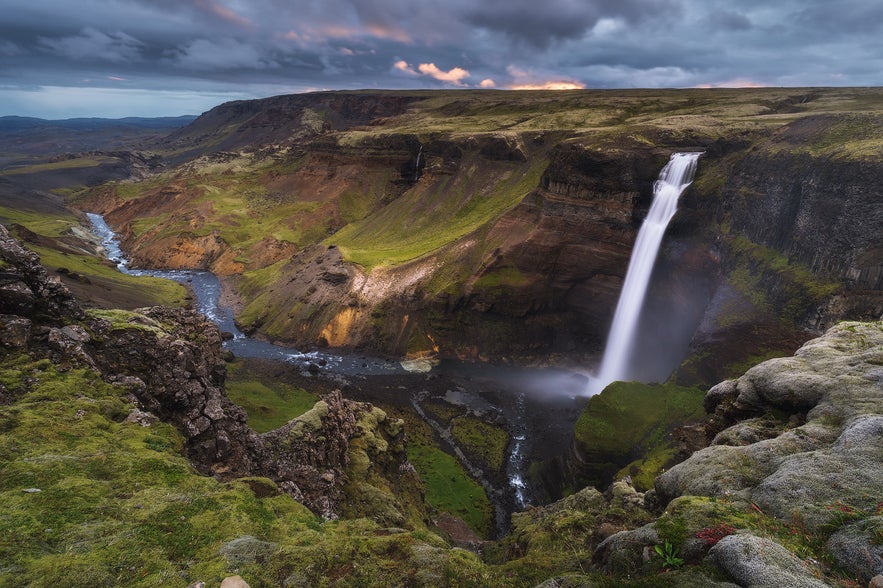 At an astounding 400 feet (122 meters) high, Haifoss is the fourth tallest waterfall in Iceland. The name of it means "Tall Falls," as many proud Icelanders thought it to be the tallest waterfall in all of Europe when it acquired its name in the 19th century. Since then, taller falls have been found in the country and elsewhere in Europe, but it's still among the ten tallest waterfalls in Europe.
At an astounding 400 feet (122 meters) high, Haifoss is the fourth tallest waterfall in Iceland. The name of it means "Tall Falls," as many proud Icelanders thought it to be the tallest waterfall in all of Europe when it acquired its name in the 19th century. Since then, taller falls have been found in the country and elsewhere in Europe, but it's still among the ten tallest waterfalls in Europe.
Located in the Thjorsardalur Valley in South Iceland, this waterfall can only be reached by renting a 4x4 vehicle, as you will need to drive on a gravel road and possibly cross some small rivers. Alternatively, you can park your car and hike the last 4.5 miles (7.2 kilometers).
Granni waterfall. Photo by Regína Hrönn Ragnarsdóttir
As Haifoss flows down a cliff and into a valley, you will have a great vantage point on the other side of the gorge, giving you a full view of the waterfall. Close to it, you can see Granni waterfall, which translates to "Neighbor." It's no slouch either, as it has a height of 331 feet (101 meters).
Both of these waterfalls are well worth a visit, especially during the summer when a perpetual rainbow usually forms around them.
13. Hraunfossar Waterfall
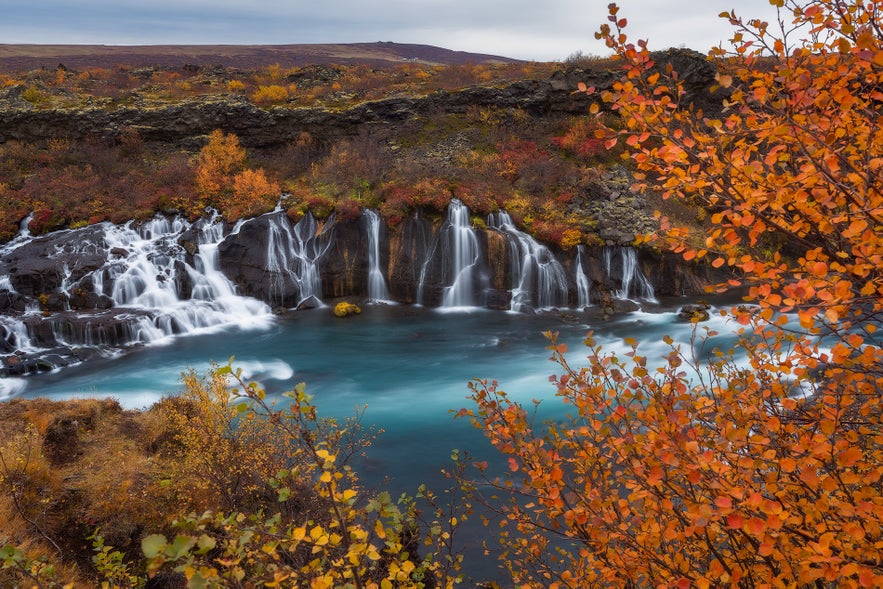 These stunning falls are located in the fjord of Borgarfjordur in West Iceland. The waterfall consists of small streams of water flowing at the edge of the Hallmundarhraun lava field. Hallmundarhraun formed after an eruption of one of the volcanoes lying under the nearby glacier of Langjokull, the second largest ice-cap in Iceland.
These stunning falls are located in the fjord of Borgarfjordur in West Iceland. The waterfall consists of small streams of water flowing at the edge of the Hallmundarhraun lava field. Hallmundarhraun formed after an eruption of one of the volcanoes lying under the nearby glacier of Langjokull, the second largest ice-cap in Iceland.
As the water flows through the edge of the porous lava field, the name Hraunfossar appropriately translates to "Lava Falls." These waterfalls can be observed from a nearby viewing platform, making it a perfect opportunity for some nature photography.
Despite lacking in height and flow, this waterfall's serene beauty and uniqueness ensure it a spot on this list, and it's well worth visiting. The location is also convenient for waterfall hunters, as it sits beside the beautiful Barnafoss waterfall.
12. Klifbrekkufoss Waterfall
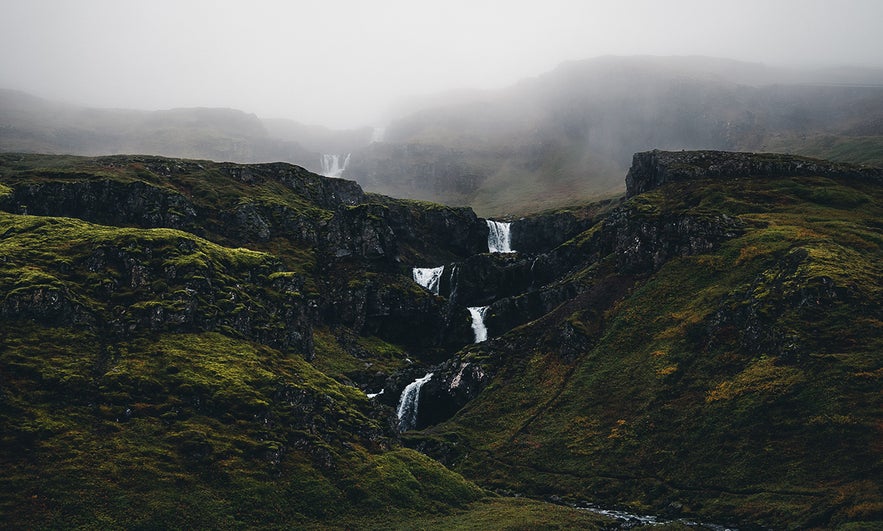
Klifbrekkufoss is a majestic waterfall with a cascading flow down seven steps of cliffs, creating a brilliant zig-zag pattern down the mountain. The waterfall is located in East Iceland, better known for its dramatic fjords and roaming reindeer. Therefore, this is a unique natural wonder in the region and somewhat of a hidden gem.
The waterfall is accessible from a nearby gravel road, but no designated parking or official hiking trails are associated with it. If you're hoping to see this pristine seven-step waterfall, make sure you do it in the summer, as the road toward it is closed during winter!
If you want to see this unique waterfall, it is located near the town of Egilsstadir, known as the region's capital. Many East Fjords tours will take you to Klifbrekkufoss waterfall, or you can combine it with a visit to the Vok geothermal baths, located just 18 miles (30 kilometers) from the waterfall.
- Learn more: The Best Places to Visit in East Iceland
11. Aldeyjarfoss Waterfall
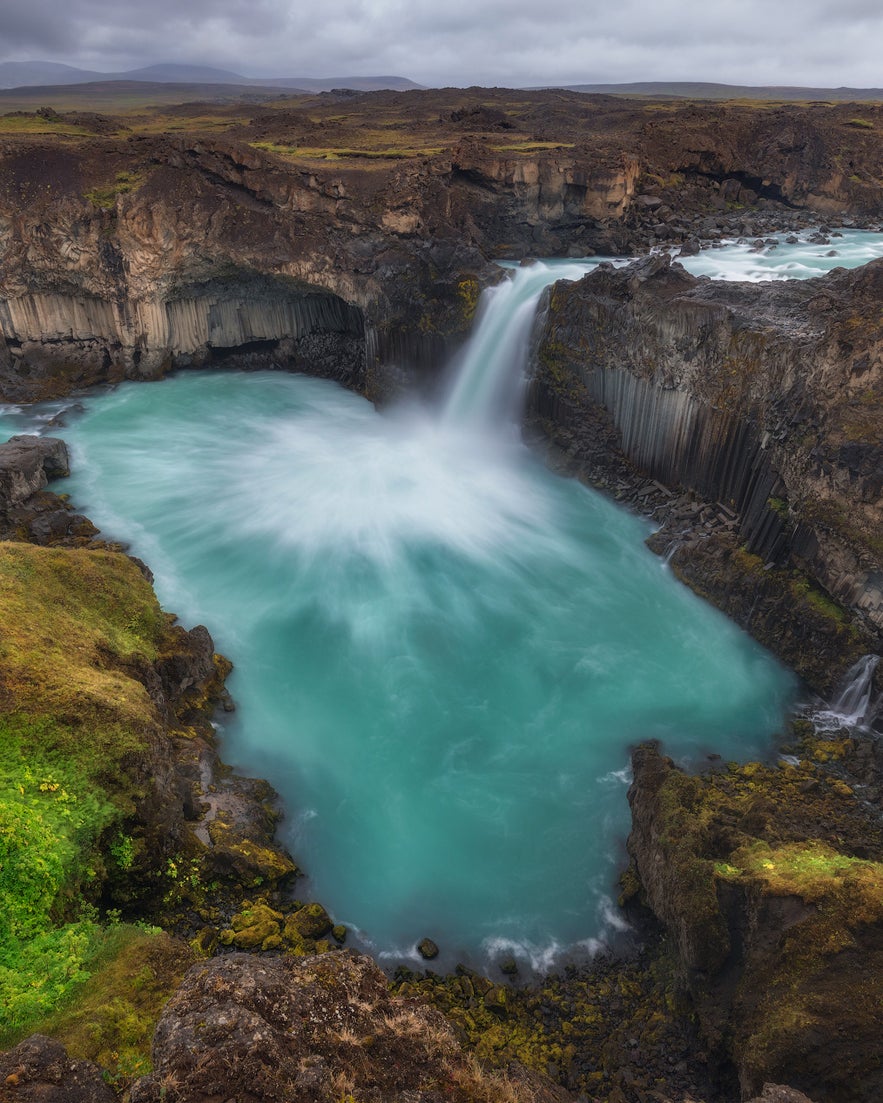 Aldeyjarfoss waterfall stands out for its distinct backdrop of basalt columns surrounding its water flow as it cascades into an icy blue pond. It stands 65 feet (20 meters) tall, and the fascinating contrast between the white water of the falls and the dark basalt columns makes this waterfall a photographer's dream.
Aldeyjarfoss waterfall stands out for its distinct backdrop of basalt columns surrounding its water flow as it cascades into an icy blue pond. It stands 65 feet (20 meters) tall, and the fascinating contrast between the white water of the falls and the dark basalt columns makes this waterfall a photographer's dream.
These columns are so perfectly formed and symmetrical that they seem to be carved by hand, but they form when lava rapidly cools down following a volcanic eruption. These columns can be found widely in Iceland, but at Aldeyjarfoss waterfall, they are unusually colorful, with shades of yellow and red created by sulfur and iron.
This waterfall is located in the northern Highlands of Iceland and is a bit off the beaten path. You will need to travel on Iceland's famous F-roads to reach it, which can only be driven with a four-wheel-drive vehicle. You can find a range of options for Iceland car rental here. During winter, ice covers the hexagonal basalt columns along the waterfall, making it look even more otherworldly.
10. Kvernufoss Waterfall
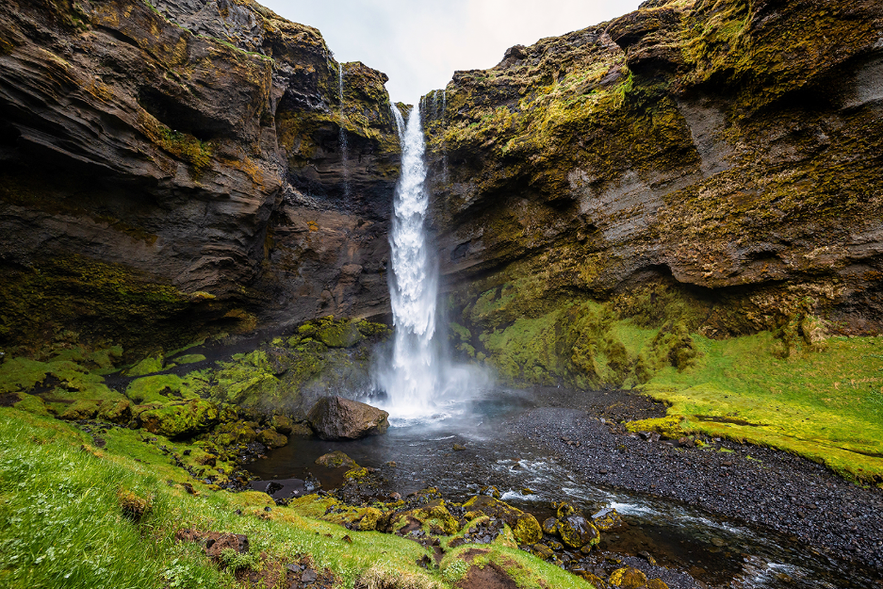 Kvernufoss is one of many beautiful waterfalls in South Iceland. However, despite being just as pretty to look at, it doesn't have the same name recognition as some of the more famous falls in the south (which appear later on this list!).
Kvernufoss is one of many beautiful waterfalls in South Iceland. However, despite being just as pretty to look at, it doesn't have the same name recognition as some of the more famous falls in the south (which appear later on this list!).
The waterfall is 98 feet (30 meters) high and is half-hidden in a dramatic gorge that surrounds its water flow as it falls into the Kverna river. Lush green vegetation on the cliff surrounding the waterfall adds to its beauty. On good days, it's even possible to walk behind it.
Kvernufoss is close to the larger and more famous Skogafoss waterfall, and it's about a 20-minute hike to reach it from the nearby Skogar museum. Being tucked away in a gorge, the waterfall can only be seen when looking directly at it from the river it flows into.
9. Hrauneyjafossar Waterfall
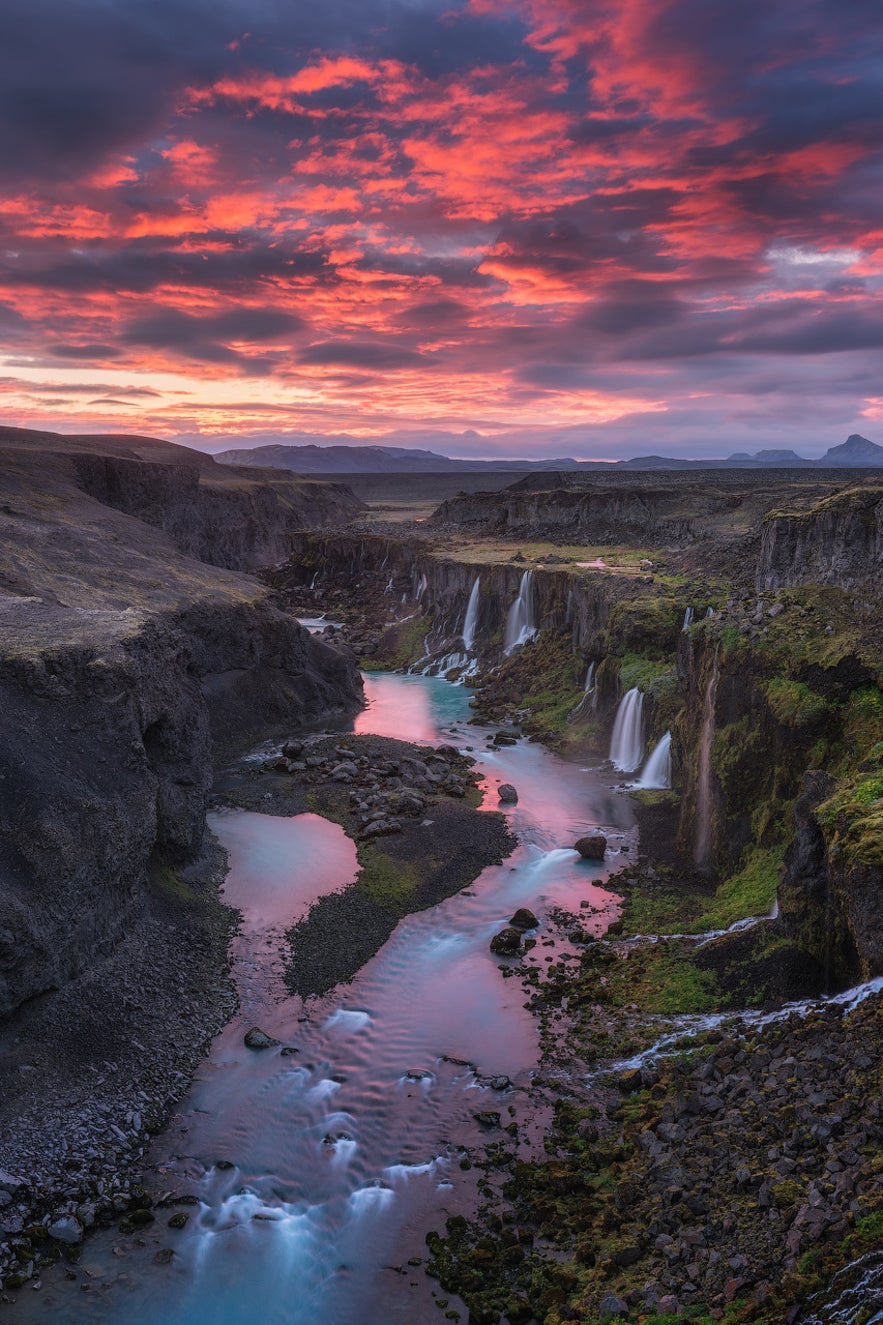 This series of cascading waterfalls falling down steep cliffs is known by a few names in Icelandic. The waterfall is called Hrauneyjafossar (Lava Islands Falls), Lekafossar (Leaking Falls), and Fogrufossar (Beautiful Falls), and each name is appropriate in its own way (especially the last one).
This series of cascading waterfalls falling down steep cliffs is known by a few names in Icelandic. The waterfall is called Hrauneyjafossar (Lava Islands Falls), Lekafossar (Leaking Falls), and Fogrufossar (Beautiful Falls), and each name is appropriate in its own way (especially the last one).
The reason for the inconsistent naming of these waterfalls is that they are relatively young compared to the others on this list, so a naming convention has not yet been established. These waterfalls were formed after a nearby hydropower plant was built in the 1970s. The overflowing water from the hydro plant's reservoir Krokslon runs into Sigoldugljufur canyon, leaking through the lava cliffs, creating this series of breathtaking waterfalls.
Does that mean these are artificial waterfalls? Would unique waterfalls like these ever form under natural circumstances? Does that make them any less majestic? Whatever the case may be, they are beautiful to look at, which gives them a place on this list.
8. Glymur Waterfall
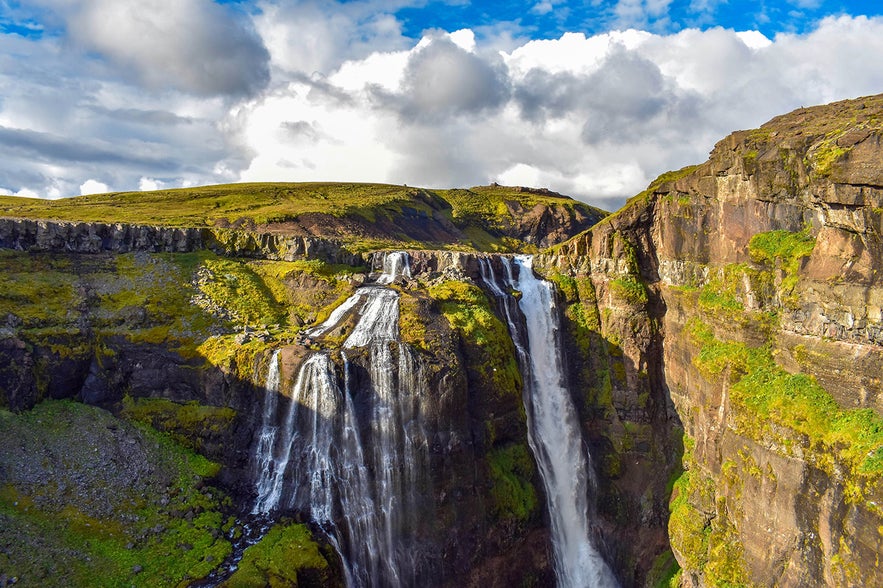 Glymur waterfall is the second tallest waterfall in Iceland, measured at 650 feet (198 meters), and is located in the Hvalfjordur fjord, not far from Reykjavik. It used to be the tallest waterfall in Iceland for centuries, but the newly discovered Morsarfoss took the crown in 2011.
Glymur waterfall is the second tallest waterfall in Iceland, measured at 650 feet (198 meters), and is located in the Hvalfjordur fjord, not far from Reykjavik. It used to be the tallest waterfall in Iceland for centuries, but the newly discovered Morsarfoss took the crown in 2011.
The waterfall is located in a narrow canyon as it falls into Botnsa river, making it hard to see the whole waterfall from one angle. It features several little falls of different sizes cascading down a mountain face.
Getting to the waterfall requires a two-hour hike through beautiful scenery, including river crossings and a cave, making it an excellent trip for photography lovers. Try this 6-hour hiking tour to Glymur, which takes you to the waterfall and explores the beautiful surrounding area.
The legend behind the waterfall's name comes from old Icelandic folklore about a man who was turned into a whale by an elf woman after betraying her. In a rage, the whale sank a boat in the Hvalfjordur fjord, and two sons of an old priest drowned.
When the old priest learned of this, he managed to lure the whale up Botnsa river until he crashed into the canyon where Glymur waterfall is located. The crash created a loud boom and caused an earthquake in the region. That's how it got its name, which means a "loud, echoing rumble."
7. Dettifoss Waterfall
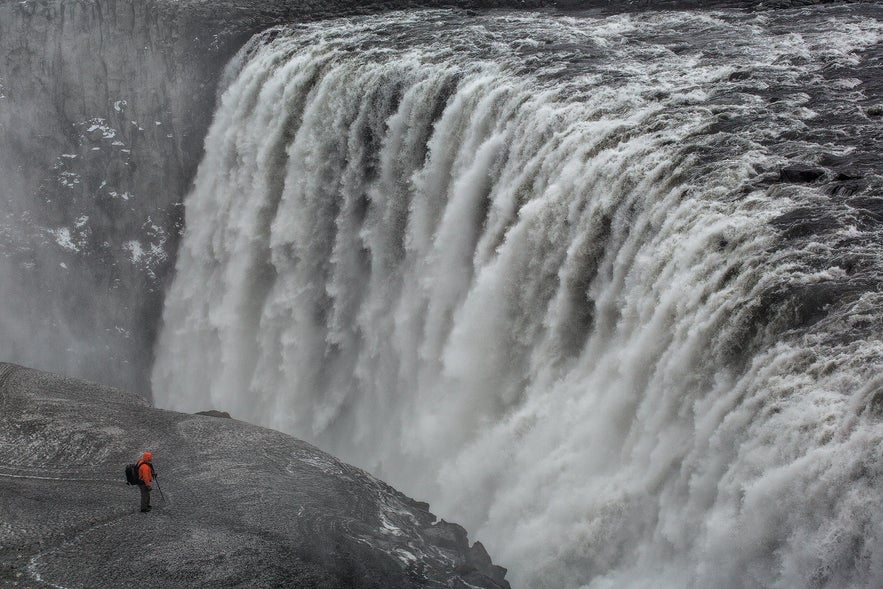
Dettifoss is the most powerful waterfall in Iceland and the second most powerful waterfall in Europe after the Rhine Falls in Switzerland. Therefore, it takes its place on this list with its sheer force and raw beauty.
Located in the Vatnajokull National Park in North Iceland, it's 330 feet (100 meters) wide and sends an impressive 7,000 cubic feet (200 cubic meters) of water per second crashing over a 144-foot (44-meter) cliff. One of the most remarkable features is the overwhelming roar of the water tumbling down the gorge. The water is grey-white due to the sediment-rich runoffs.
The waterfall's name directly translates to "Tumbling Falls," and it's a thrilling feeling standing next to such an immense force of nature. The Dettifoss waterfall featured in the opening scene of the Hollywood blockbuster Prometheus and served as the place where life on Earth began.
Dettifoss waterfall is a part of the famed Diamond Circle sightseeing route. You can easily reach it on this 9-Hour Diamond Circle Tour with a transfer from Akureyri.
6. Svartifoss Waterfall
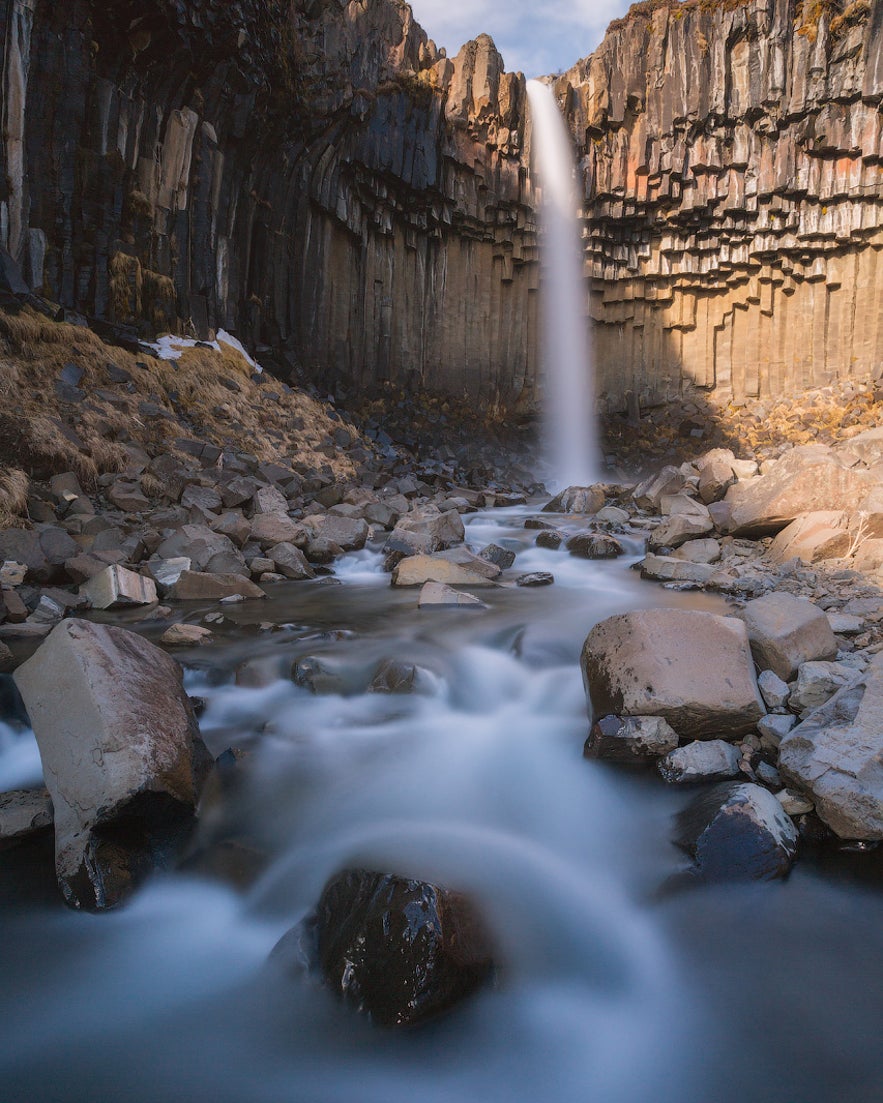 The Svartifoss waterfall is located in the Skaftafell Nature Reserve in Southeast Iceland. It's 65 feet (20 meters) tall, and a wooden bridge crosses the stream near the waterfall, which is ideal for photography opportunities.
The Svartifoss waterfall is located in the Skaftafell Nature Reserve in Southeast Iceland. It's 65 feet (20 meters) tall, and a wooden bridge crosses the stream near the waterfall, which is ideal for photography opportunities.
Svartifoss translates to "Black Falls" because of the dramatic contrast between the white water and dark hexagonal basalt columns. At the base of the falls sit sharp rocks that have broken from the columns, giving the waterfalls an otherworldly feel.
This picturesque feature of the waterfall inspired the columnar architecture of the Hallgrimskirkja church in Reykjavik and the ceiling of the National Theater of Iceland.
The hike from the Skaftafell visitor center to Svartifoss waterfall is about one mile (1.5 kilometers) and is accessible year-round. There are three smaller waterfalls below Svartifoss which you can see on the hike toward the waterfall along the river's east bank.
5. Godafoss Waterfall
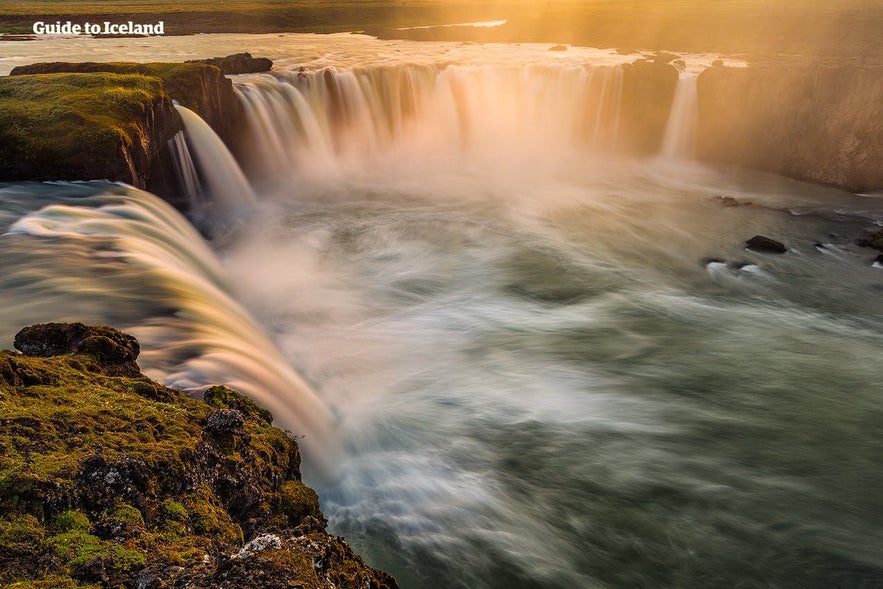 Godafoss waterfall, at 39 feet (12 meters) high and 98 feet (30 meters) wide, is one of Iceland's most famous waterfalls. It has a half-circular shape of multiple streams of water falling into the fourth largest river in Iceland, Skjalfandafljot. It can be reached on this fantastic 9-hour North Iceland tour from Akureyri.
Godafoss waterfall, at 39 feet (12 meters) high and 98 feet (30 meters) wide, is one of Iceland's most famous waterfalls. It has a half-circular shape of multiple streams of water falling into the fourth largest river in Iceland, Skjalfandafljot. It can be reached on this fantastic 9-hour North Iceland tour from Akureyri.
This waterfall has a special place in Icelandic history which lives on in its name. The original Norse settlers of Iceland worshipped the pagan gods of the Norse pantheon, such as Odin, Thor, and Freya. But in the year 1000, the King of Norway threatened an invasion if Iceland didn't become Christian.
Thorgeir Ljosvetningagodi, the lawspeaker of Iceland's national assembly Althingi, is said to have laid under a fur blanket for days while praying to the Norse god to find a solution to the situation. Eventually, he emerged and declared that Christianity would become the official religion of Iceland, while pagans could still practice their beliefs in private.
As a symbol of his decision, he returned to his home in North Iceland and threw his idols of the Norse gods into this beautiful waterfall, which gave it its name, "Waterfall of Gods."
4. Dynjandi Waterfall
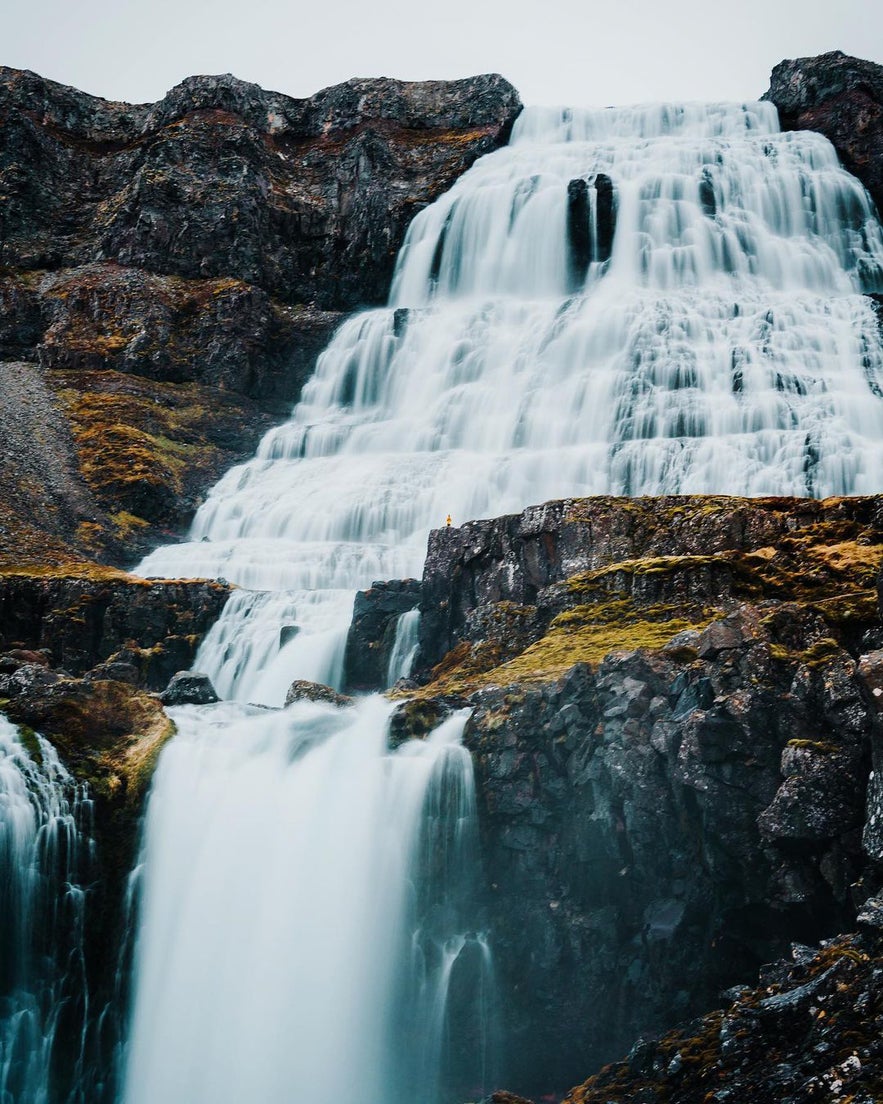 Dynjandi waterfall can be found in the beautiful Westfjords, the only one on this list in the region. It's close to Dynjandisvogur bay and Arnarfjordur fjord, an area widely famed for its wealth of birdlife, stunning natural vistas, and picturesque coastlines.
Dynjandi waterfall can be found in the beautiful Westfjords, the only one on this list in the region. It's close to Dynjandisvogur bay and Arnarfjordur fjord, an area widely famed for its wealth of birdlife, stunning natural vistas, and picturesque coastlines.
Colloquially titled "the Jewel of the Westfjords," Dynjandi (otherwise known as Fjallfoss) cascades approximately 328 feet (100 meters) in total, falling in a trapezoidal shape. It is 98 feet (30 meters) wide at the top and 196 feet (60 meters) at the bottom. Its dramatic shape and sheer size are sure to take your breath away, making it almost intimidating to see in person.
Dynjandi is particularly beloved by visiting nature enthusiasts and aspiring photographers, who can snapshot this fantastic natural feature from several angles. Its name translates to "Thundering," which references the loud droning sound of this marvelous waterfall.
3. Seljalandsfoss Waterfall
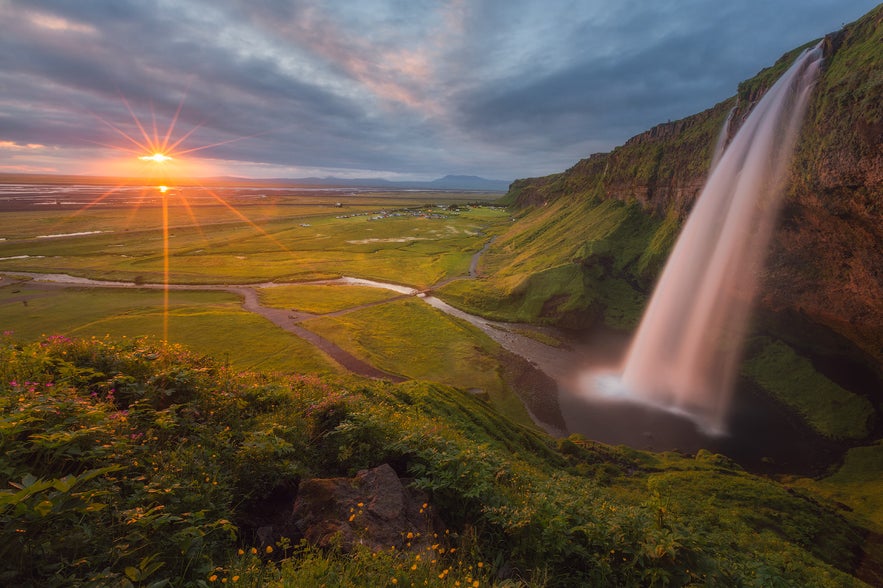 Seljalandsfoss waterfall is hugely popular and among the best waterfalls in Iceland. Located on the South Coast of Iceland, roughly 80 miles (128 kilometers) from Reykjavik. Seljalandsfoss waterfall is one of the most photographed waterfalls in the country and is a guaranteed stop on the many South Coast tours in Iceland.
Seljalandsfoss waterfall is hugely popular and among the best waterfalls in Iceland. Located on the South Coast of Iceland, roughly 80 miles (128 kilometers) from Reykjavik. Seljalandsfoss waterfall is one of the most photographed waterfalls in the country and is a guaranteed stop on the many South Coast tours in Iceland.
The waterfall is narrow and tall at 197 feet (60 meters) high and boasts the rare feature of a path circling it. The trail enables visitors to walk behind it and take spectacular photos (while getting soaking wet in the process). Just a short walk from Seljalandsfoss, you can find another unique waterfall worth visiting, called Gljufrabui waterfall.
The name Gljufrabui directly translates to "Canyon Dweller," as it is hidden between tall cliffs, which you need to get through. The official name of the waterfall is Gljufurarfoss, which refers to the Gljufura river it flows into.
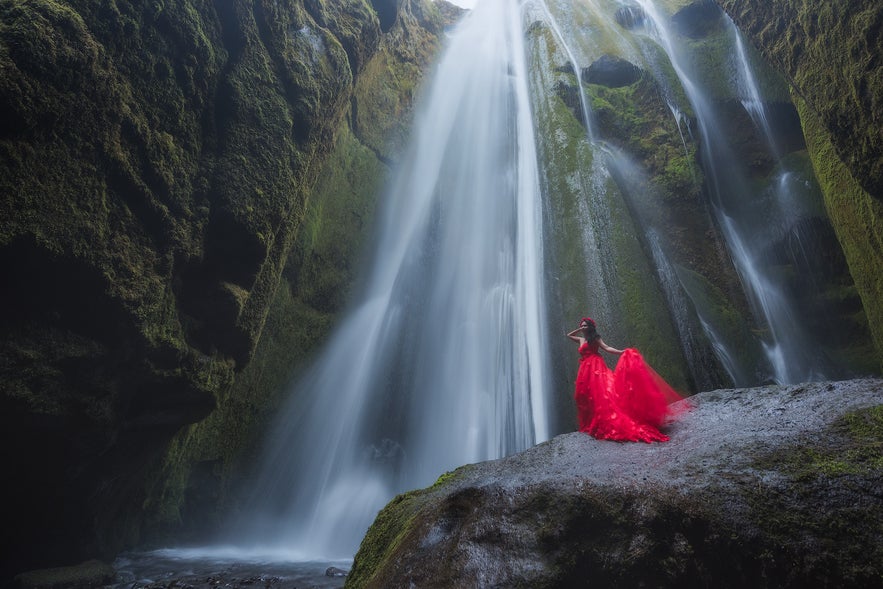
Seljalandsfoss waterfall is considered one of Iceland's most picturesque waterfalls and is essential to experience when visiting the country. It can be reached on a day tour from Reykjavik, making it very accessible for visitors year-round.
2. Gullfoss Waterfall

Gullfoss waterfall is fed by the Hvita glacier river in South Iceland, where it drops down 105 feet (32 meters) into a narrow river gorge via two tiers. You can even walk near enough to feel the water spray on your face in clear weather. Be sure to stay within the fence for safety and be extra careful while visiting in the winter, as it may be slippery.
At the beginning of the last century, Gullfoss was at the center of a controversy regarding British investors planning to utilize the waterfall's energy for a hydroelectric plant. Sigridur Tomasdottir, a daughter of the farmer who owned the land adjacent to the waterfall, ensued a legal battle against the investors to prevent the building of the hydro plant. She even threatened to throw herself in the waterfall if construction began.
Eventually, the investors withdrew from the lease, and ownership of the waterfall fell back into the hands of the Icelandic people. To commemorate her successful campaign to protect Iceland's nature, a plaque was raised in her honor near the Gullfoss waterfall.
1. Skogafoss Waterfall
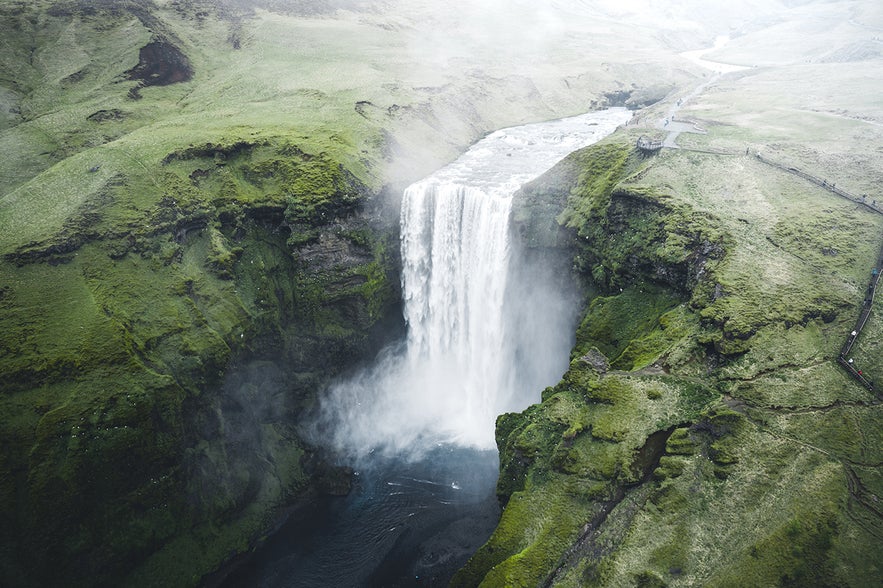 Skogafoss is a majestic waterfall on the South Coast of Iceland, close to the village of Skogar, from which it draws its name. It has an astounding width of 82 feet (25 meters) and is 197 feet (60 meters) tall. Skogafoss is one of Iceland's most dramatic waterfalls and, dare we say, the most beautiful waterfall in Iceland.
Skogafoss is a majestic waterfall on the South Coast of Iceland, close to the village of Skogar, from which it draws its name. It has an astounding width of 82 feet (25 meters) and is 197 feet (60 meters) tall. Skogafoss is one of Iceland's most dramatic waterfalls and, dare we say, the most beautiful waterfall in Iceland.
Many of the waterfalls on this list have a unique feature that garners a place, such as being exceptionally tall or powerful or having a scenic location. For Skogafoss, it's not just one of those things that put it at spot number one, but a combination of many. It's an iconic waterfall worth visiting for anyone coming to Iceland.
Skogafoss is conveniently located in South Iceland and is easy to visit from Reykjavik in a day. You can walk right up to it, depending on how wet you're willing to get. Photographers should note that it may produce a rainbow (or even double!) on sunny days due to the interplay between the spray and the sunlight (as seen below).
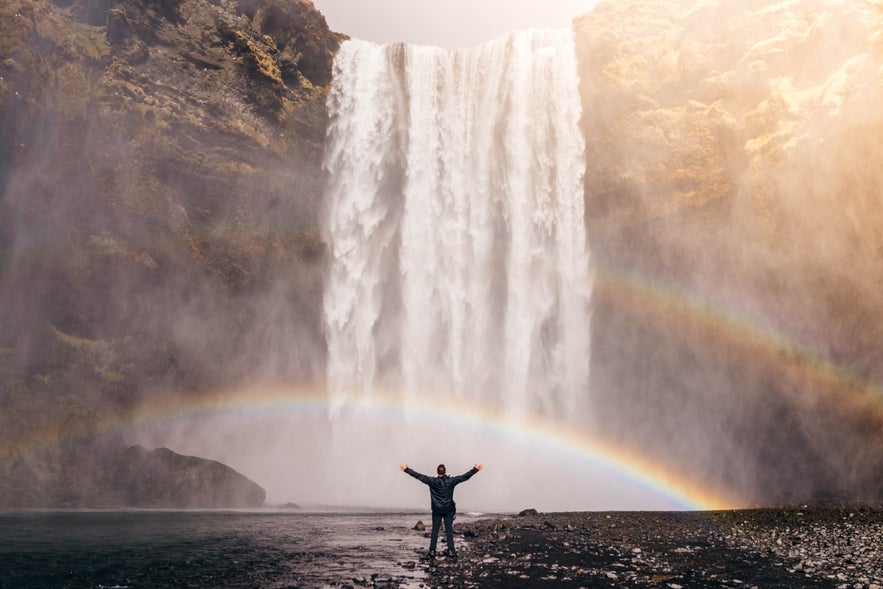 It's the type of waterfall that could be in the dictionary next to the word "waterfall." Not only is it breathtaking to look at, but the waterfall also has a fascinating story, adding to its mystique.
It's the type of waterfall that could be in the dictionary next to the word "waterfall." Not only is it breathtaking to look at, but the waterfall also has a fascinating story, adding to its mystique.
During the settlement of Iceland, a sorcerer named Thrasi Thorlaksson was said to have buried a treasure chest in the cave behind the waterfall. In the 17th century, a group of men was said to have found the treasure chest.
However, as they tried pulling on the chest, the ring on the chest broke off, and the treasure chest disappeared into the cave. You can view this mysterious ring if you visit the Skogar museum nearby, where it's on display.
Skogafoss is easy to access while traveling on the Ring Road and is included in all South Coast tours, which are a great way to visit the waterfall any time of year. Seljalandsfoss waterfall is only 18.5 miles (30 kilometers) away, so both can be seen on the same day. You can stay in close proximity to these natural wonders by booking a hotel in South Iceland.
The complete list of the 20 most beautiful waterfalls in Iceland
1. Skogafoss Waterfall
2. Gullfoss Waterfall
3. Seljalandsfoss Waterfall
4. Dynjandi Waterfall
5. Godafoss Waterfall
6. Svartifoss Waterfall
7. Dettifoss Waterfall
8. Glymur Waterfall
9. Hrauneyjafoss Waterfall
10. Kvernufoss Waterfall
11. Aldeyjarfoss Waterfall
12. Klifbrekkufoss Waterfall
13. Hraunfossar Waterfall
14. Haifoss Waterfall
15. Bruarfoss Waterfall
16. Kirkjufellsfoss Waterfall
17. Hengifoss Waterfall
18. Hrafnbjargarfoss Waterfall
19. Selfoss Waterfall
20. Oxararfoss Waterfall
Map of the most beautiful waterfalls in Iceland
What did you think of this list of the most beautiful waterfalls in Iceland? Which ones would you most like to visit? Are there any waterfalls you have visited and would add to this list? Let us know in the comments below.
Weitere interessante Artikel
20 Island-Geheimtipps: Verlasse die ausgetretenen Pfade
Entdecke versteckte Juwelen in Island. Island ist ein Land voller Naturwunder – von vulkanischen Kratern über Geysire bis hin zu riesigen Gletschern und Wasserfällen. Viele von ihnen sind berühmt gewo...Weiterlesen
Die 20 besten Festivals in Island
Entdecke die besten Feste in Island und was sie so einzigartig macht. Welche isländischen Festivals sind die größten? Welches sind die besten Festivals in Reykjavik? Und wann und wo finden die Festi...Weiterlesen
VIP Club von Guide to Iceland: Ein umfassender Guide
Als Kunde von Guide to Iceland hast du nicht nur Zugang zur größten Auswahl an Touren, Unterkünften und Mietwagen in Island, sondern auch zu tollen Rabatten und Sonderangeboten in verschiedenen Einr...Weiterlesen

Lade Islands größten Reisemarktplatz auf dein Handy herunter, um deine gesamte Reise an einem Ort zu verwalten
Scanne diesen QR-Code mit der Kamera deines Handys und klicke auf den angezeigten Link, um Islands größten Reisemarktplatz in deine Tasche zu laden. Füge deine Telefonnummer oder E-Mail-Adresse hinzu, um eine SMS oder E-Mail mit dem Download-Link zu erhalten.
